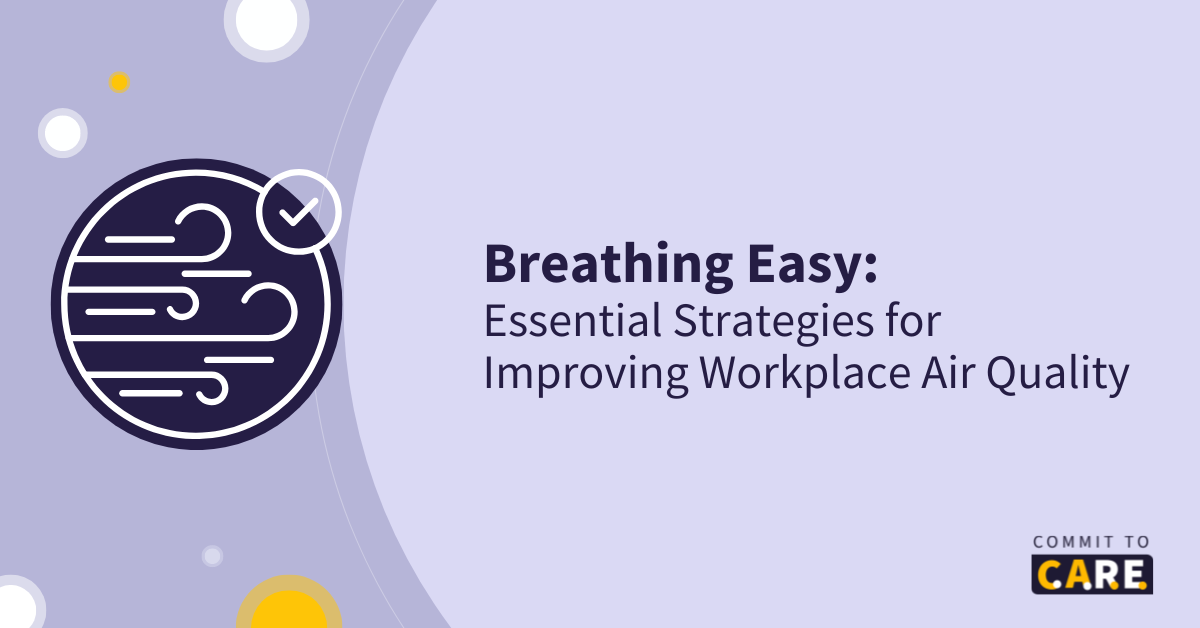Breathing Easy: Essential Strategies for Improving Workplace Air Quality

The air quality inside our workplaces significantly impacts health, comfort, and productivity. In the wake of global health challenges like COVID-19, there’s a heightened awareness of the importance of managing Indoor Air Quality (IAQ). Implementing effective strategies can reduce the risk of airborne diseases and enhance overall workplace wellness. This post leverages expert insights to provide actionable steps for improving IAQ in various work environments.
Understanding Airborne Transmission
Viruses that transmit as airborne particles, such as the viruses that cause COVID-19, flu, and measles, pose such a significant risk as they can squeeze into small places, nearly 10,000 times smaller than a human hair, travel long distances, up to 20 to 30 feet, and stay active in the air for at least 4 hours.
When you think about viral aerosols or viruses that transmit as airborne particles, think of them as water moving in a stream. Like the water, they will find the easiest path from one point to the next. With a rock or log in a stream, the water in the stream will find a path around it.
Key Strategies for Improving IAQ
Optimize Ventilation Systems
- Enhanced Airflow: Modify HVAC systems to maximize the intake of fresh outdoor air, diluting accumulated indoor pollutants and reducing potential airborne transmission.
- Air Exchanges per Hour: Implement the correspondent ‘air exchanges per hour’ of spaces before and after occupancy to purge stale air and fill spaces with fresh, filtered air.
Monitor and Maintain Air Quality
- CO2 Monitoring: Deploy CO2 monitors to provide real-time alerts when there is insufficient ventilation, prompting immediate adjustments.
- Particulate Sensors: Install sensors that measure particulate matter, ensuring that filters and other air cleaning systems effectively remove potential pathogens.
Implement Advanced Filtration
- HEPA Filters: Equip air handling systems with HEPA filters to capture fine particulates and pathogens effectively.
- Regular Maintenance: Schedule regular inspections and maintenance of air filtration systems to maintain optimal performance over time.
Tailored IAQ Solutions for Different Work Environments
Each workplace environment presents unique challenges that require specific strategies:
- Schools: Implement enhanced ventilation and air purifiers in classrooms to protect students and staff, especially in frequently used spaces or with poor natural ventilation.
- Construction Sites: Use heavy-duty air filtration units to manage dust and particulate matter, and ensure that workers are trained on and adhere to safety protocols to minimize inhalation risks.
- Healthcare Facilities: Apart from using HEPA filters, employ UV germicidal irradiation in critical areas to neutralize airborne pathogens effectively, providing an additional layer of protection.
- General Office Settings: Optimize HVAC settings to increase fresh air intake and use scheduled ventilation to reduce pollutants. Adding portable air purifiers with HEPA filters in areas with limited airflow and implementing regular maintenance of air handling systems can significantly improve air quality, creating a healthier environment for all employees.
Extended Insights for IAQ Excellence
A multifaceted approach that extends beyond immediate technical solutions is essential to achieve excellence in Indoor Air Quality (IAQ) across various workplaces. These extended insights focus on integrating holistic strategies that encompass policy updates, economic understanding, and community engagement:
- Regular Updates to IAQ Standards: Updating IAQ standards to incorporate the latest scientific findings and technological advancements ensures that workplace environments align with best practices for health and safety.
- Economic Impact Awareness: Understanding the broader economic impacts of IAQ is vital. Improved air quality has been linked to enhanced employee productivity, reduced absenteeism, and lower healthcare costs.
- Cultivating a Health-Conscious Workplace Culture: Promoting a workplace culture that values health and well-being can significantly enhance IAQ initiatives.
- Engaging and Educating Employees: Employee engagement is key to successful IAQ management. Regular training sessions, workshops, and communication campaigns about the importance of IAQ and personal contributions to maintaining air quality can empower employees and encourage their active participation in IAQ practices.
- Interdisciplinary Collaboration: Encouraging collaboration between various departments, such as facilities management, HR, and health and safety committees, can lead to more innovative and effective IAQ solutions.
- Community Involvement and Feedback: Involving the broader community in IAQ discussions and decision-making processes can enhance the effectiveness of implemented strategies.
- Policy Advocacy: Advocate for policies that promote better IAQ standards at a regional or national level.
Enhancing indoor air quality is an ongoing commitment that requires concerted effort and collaboration across all levels of an organization. By integrating the strategies outlined in this post, businesses can significantly improve their work environments, leading to better health outcomes and increased productivity. Let’s take proactive steps towards breathing easier and creating safer, healthier workplaces.
Download the Improving Indoor Air Quality (IAQ) in the Workplace infograhic
This guide provides practical strategies to improve Indoor Air Quality (IAQ) in the workplace, focusing on ventilation, filtration, and tailored solutions for different environments to enhance health and safety.


